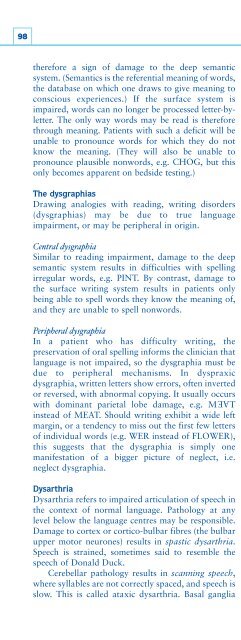You also want an ePaper? Increase the reach of your titles
YUMPU automatically turns print PDFs into web optimized ePapers that Google loves.
98therefore a sign of damage to the deep semanticsystem. (Semantics is the referential meaning of words,the database on which one draws to give meaning toconscious experiences.) If the surface system isimpaired, words can no longer be processed letter-byletter.The only way words may be read is thereforethrough meaning. Patients with such a deficit will beunable to pronounce words for which they do notknow the meaning. (They will also be unable topronounce plausible nonwords, e.g. CHOG, but thisonly becomes apparent on bedside testing.)The dysgraphiasDrawing analogies with reading, writing disorders(dysgraphias) may be due to true languageimpairment, or may be peripheral in origin.Central dysgraphiaSimilar to reading impairment, damage to the deepsemantic system results in difficulties with spellingirregular words, e.g. PINT. By contrast, damage tothe surface writing system results in patients onlybeing able to spell words they know the meaning of,and they are unable to spell nonwords.Peripheral dysgraphiaIn a patient who has difficulty writing, thepreservation of oral spelling informs the clinician thatlanguage is not impaired, so the dysgraphia must bedue to peripheral mechanisms. In dyspraxicdysgraphia, written letters show errors, often invertedor reversed, with abnormal copying. It usually occurswith dominant parietal lobe damage, e.g. M Tinstead of MEAT. Should writing exhibit a wide leftmargin, or a tendency to miss out the first few lettersof individual words (e.g. WER instead of FLOWER),this suggests that the dysgraphia is simply onemanifestation of a bigger picture of neglect, i.e.neglect dysgraphia.AEDysarthriaDysarthria refers to impaired articulation of speech inthe context of normal language. Pathology at anylevel below the language centres may be responsible.Damage to cortex or cortico-bulbar fibres (the bulbarupper motor neurones) results in spastic dysarthria.Speech is strained, sometimes said to resemble thespeech of Donald Duck.Cerebellar pathology results in scanning speech,where syllables are not correctly spaced, and speech isslow. This is called ataxic dysarthria. Basal gangliadisorders result in monotonous quiet speech, socalledhypokinetic dysarthria. Damage to X or XIInuclei or nerves results in a flaccid dysarthria. Speechis nasal, and ultimately progresses to total anarthria(loss of speech).CAUSES OF LANGUAGE DISORDERWhile the above classification helps to localize wherethe problems causing language and speech disorderare, the rate of evolution of the symptoms helps todetermine the nature of the pathologic process (Table14). For example, sudden onset of speech or languageimpairment is often due to stroke, which is thecommonest cause of speech and language impairment.Twenty to 30% of all strokes have some degree oflanguage or speech impairment, and this can be theonly symptom, with no evidence of hemiparesis orother neurological impairment. By contrast, insidiousonset and progressive impairment are suspicious oftumour or neurodegenerative disease.CLINICAL ASSESSMENTSpecific ‘focused’ history takingThe patient and carer should be asked specificallyabout problems understanding others’ speech andwriting, and also whether the patient has a problemTable 14 Causes of language impairmentAphasia ❏ Focal lesions– Stroke– Tumour– Abscess❏ Dementia– Alzheimer's– Fronto-temporalDysarthria ❏ Spastic– UMN, e.g. stroke, tumour❏ Ataxic– Cerebellar lesion❏ Hypokinetic– Basal ganglia, e.g. Parkinson'sdisease❏ Flaccid– LMN, e.g. MNDLMN: lower motor neurone; MND: motor neurone disease;UMN: upper motor neurone.
















